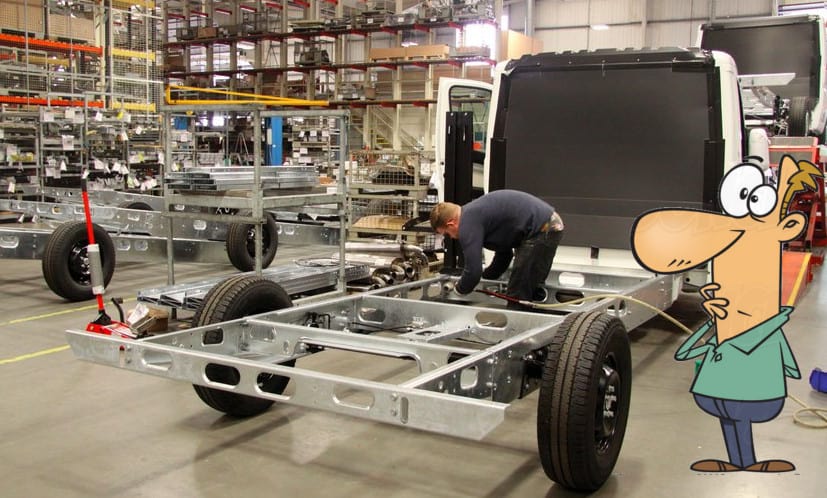
We have guests who turn up to Horton Common in a whole range of motorhomes of various shapes and sizes. I even have some guests who have built their own motorhomes. I’ve previously written a post on motorhome panel van conversions, on how they are built and their pros and cons. So with this post, I thought I would discuss how coach-built motorhomes are made, starting with the chassis and then building out the habitation area to place on top. There are lots of motorhome manufacturers in the UK and Europe. Some are based on lightweight AL-KO chassis. Others are based on heavy-duty commercial chassis.

While one of the videos I reference below on how motorhomes are built is from a manufacturer’s factory, the point of this post is not to emphasise one particular method of construction over another.
Each motorhome construction method has different pros and cons. Some methods are more lightweight to keep under 3,500kg. Other motorhomes are built off a heavy-duty commercial chassis.
Yes, this will add weight, but it also means a larger/heavier habitation area can be placed on that chassis.
Also, a motorhome with a commercial chassis is going to be more suitable for towing a car behind etc. So, motorhomes are built differently for different reasons.
Horses for courses, each to their own, etc etc. Also, in the coming years, how motorhomes are built will see changes. For instance, I recently wrote a post on an electric motorhome.
Disclaimer: Hey! By the way… any links on this page that lead to products on Amazon or Caravan Guard are affiliate links, and I earn a commission if you make a purchase, with no additional cost to you 🙂
- Dissolves waste and removes odours naturally and has delightful mild fragrance
Want To Visit Horton Common? – Book Here
Table of Contents
Introduction To How A Motorhome Is Built
‘Back in the day’ most motorhomes were simply built on the commercial chassis that the van manufacturers provided.
Now, there are still motorhomes produced on commercial chassis today, and it comes with various benefits. More on that below.
However, if you want to make a smaller motorhome that will be as fuel-efficient as possible, a heavy thick gauge steel chassis is a bit OTT (Over The Top).
Therefore, many modern motorhomes found on UK roads today are based on a thinner and lighter chassis which is bolted together instead of welded together.
By using high-strength bolts in sufficient numbers its possible to produce a very strong motorhome chassis that is also very light.
I knew about the AL-KO chassis system, which many motorhomes are built on, but I’d never actually seen its construction before until I watched the video below.
So as John discusses in the video, several years back, AL-KO would receive from the cab manufacturer pretty much a full vehicle with a cab and a commercial chassis.
They would then have to cut off that heavy steel welded chassis and dispose of it. Yes, of course, that steel would be recycled, but it was an inefficient and costly way to start a build.
Since AL-KO didn’t want the heavy-duty steel commercial chassis in the first place, it wasn’t the best idea to transport it to them in that state.
But you obviously need to transport the cabs with four wheels, so what else could they do?
Well, as you can see from the video above, the solution was the ‘back-to-back arrangement’. When you see it in the video above for the first time, it definitely looks odd, but its the perfect solution.
Instead of transporting one cab and unwanted steel chassis, you can transport two cabs with no unwanted steel chassis.
It reduces transport costs of delivering the cabs to AL-KO, which means you can deliver more cabs on the same transporter, and they are not sending AL-KO steel chassis they don’t want or need. Win, Win, Win!
Ultimately, consumers do benefit from this arrangement, as it reduces the initial construction phase when building a motorhome.
The Benefits Of A Bolted AL-KO Chassis When Building A Motorhome
First, the back-to-back cab arrangement is separated, and they just fit a caravan jockey wheel on the back to move the separated motorhome cabs around.
John then also shows the type of motorhome suspension which will be built onto an AL-KO chassis motorhome as opposed to one based on a commercial chassis.
The difference is, commercial vans use leaf spring suspension setups, and AL-KO chassis-based motorhomes use torsion beam suspension setups.
Torsion Beam vs Leaf Spring Suspension When Building A Motorhome
Now, I’m going to write a separate post on motorhome suspension setups at some point because its a big topic and something you really should be paying attention to on your next motorhome purchase.
But I’ll quickly discuss why AL-KO is using a torsion beam suspension setup.
Essentially it provides better handling on lighter motorhomes. Leaf spring suspension, while literally being as old as horses and carts, still has its place on motorhomes today.
However, an empty/lightweight motorhome on leaf springs leans in corners a lot, and they take bumps/potholes pretty poorly.
So, for the lightweight motorhome market, which AL-KO chassis are for, torsion beams are the better choice.
To put it as simply as I can, torsion beam suspension is two metal beams with rubber pads in between them.
AL-KO Motorhome Chassis Are Built With Bolts & Not Welded
Depending on the length of habitation area each particular motorhome manufacturer requires, AL-KO builds the chassis to suit.
So as John references, an AL-KO motorhome chassis is built with bolts and not welded.
If you have ever looked at an AL-KO chassis under a caravan, its easier to see how it works. The metal sections are produced with cut-outs and folds, which save weight while at the same time adding strength.
You will also notice lots of potential bolt holes which are not used. AL-KO can use the same chassis components sliding inside one another to create longer or shorter chassis.
Being able to use the same components to produce both long and short chassis reduces manufacturing costs.
The metal chassis frame is then bolted together. I do a fair bit of DIY, and I imagine they are using something similar to a Nyloc nut.
Its a nut with a plastic inner lining which resists turning. Hence, it won’t easily come undone. The seat belt assemblies are also bolted directly to the chassis, which provides maxium occupant safety.
Brakes are fitted and checked, and then the motorhome cab and complete chassis are built and ready to be sent off to the motorhome coach builder.
How The Habitation Area Is Built On A Motorhome
Below is a video which demonstrates the process a motorhome coach builder goes through to build a motorhome.
Just for clarification though, the company in the video below is not using an AL-KO chassis. They are using a commercial chassis with leaf spring suspension.
The reason being their motorhomes are big heavy units. Hence, AL-KO chassis with torsion beam suspension sets are not suitable for these heavy motorhomes.
The Versatility & Strength Of Fibreglass
Practically every motorhome besides panel van conversions will have some of the body parts constructed of fibreglass.
The presenter in the video above walks onto the factory floor and describes the ‘sweet smell of fibreglass’.
I’ve done two fibreglass DIY projects myself, and while I love it as a resilient and durable material, I wouldn’t personally describe it as a nice smell.
But essentially, for the application on motorhomes, you start with a former. This provides the shape for the fibreglass component they are making.
Say, for instance, the motorhome bodywork that joints the cab to the rest of the habitation zone.
Through a couple of layers of resin and glass fibre matt, you can produce something that’s very strong and waterproof.
Motorhome manufacturers then produce the sides of the motorhome body and fit it all together.
Its then the role of the carpenters to produce the internal furniture, seat and beds along with the kitchen and bathroom. Put all that together with the chassis, and you have built a motorhome!
Conclusions On How A Motorhome Is Built
Really, this post is just a brief general look at how a motorhome is built. Each motorhome manufacturer uses slightly different materials and techniques.
Whichever motorhome you are interested in purchasing next, I would encourage you to spend some time looking into their construction techniques and materials.
The reason being it can help you make a final purchase decision on a motorhome that will better suit your needs.
For instance, if you want to tow a car behind a motorhome, ideally, you are really going to be looking at something based on a commercial chassis.
But there are other variables. Bailey, a well-known manufacturer in the caravan world, also produces motorhomes using their Alu-Tech construction technique.
This means no wood is used in the construction of the body, which has various benefits.
Anyway, I hope you learnt something new from this post on how motorhomes are built. You may also be interested in my post for motorhome beginners.
I also hope you consider at some point in the future coming to visit us here at Horton Common in the near future to experience our amazing views over the Staffordshire Moorlands and Peak District National Park. 🙂
Want To Visit Horton Common? – Book Here

